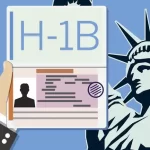The United States attracts hundreds of skilled workers worldwide every year. Central to this influx is the H-1B visa program, designed primarily for foreign professionals in specific working areas, like finance, technology, or, even, modeling. This visa not only opens doors for these talented individuals but also poses a significant question – What happens to those who accompany them? What are their dependents’ employment rights?
When a skilled worker relocates to the U.S. under an H-1B visa, they often bring their closest family members. They are their so-called dependents. These dependents are granted H-4 visas. The H-4 visa is a derivative status, meaning its validity and conditions are directly tied to the principal H-1B visa holder’s status.
This scenario sets the stage for inquiry: Can these H-1B dependents engage in employment while in the United States? The answer to this question is not just a matter of legal interpretation but also one that affects the lives of thousands of families, influencing their economic stability, personal fulfillment, and integration into American society.
Legal Work Status of H-1B Dependents
Let’s get straight to the matter. Can H-1B dependents work in the U. S.? The short answer is: sometimes, yes. But it’s not always straightforward.
First, a little reminder about who these dependents are. They’re usually the spouses and kids under 21 of H-1B visa holders. These family members get something called an H-4 visa. For a long time, people with H-4 visas couldn’t work in the U. S. This rule changed a bit in 2015. Now, some, but not all, H-4 visa holders can get permission to work.
But how? It depends on the H-1B visa holder’s situation. If the H-1B holder is on the path to getting a green card, their H-4 dependents might be able to work. They need to apply for something called an Employment Authorization Document (EAD). Getting this EAD is what allows them to work legally in the U.S. Applying for an EAD involves filling out a form and paying a fee. Once they get the EAD, H-4 dependents can work in almost any job. They can work full-time or part-time, in any kind of role. But remember, not all H-4 visa holders can get this work permit. It’s only for those whose H-1B family member is on track for permanent residency.
Also, these rules might change. Immigration policies (and, specially, immigration processes and procedures) tend to be updated. As I always tell my clients – it’s important for all of us to keep up with the latest news.
Process of Obtaining Work Authorization
Say you are on that track for the Green Card. How do your dependents get that EAD, that work authorization? It’s a process, but it’s not too complicated. Let’s break it down.
First things first, your dependents need to fill out a form. This form is called Form I-765, officially known as the Application for Employment Authorization. You can find it online on the U.S. Citizenship and Immigration Services (USCIS) website. Filling out this form is straightforward. Your dependents will need to provide some basic information about themselves. This includes their name, address, and details about their current H-4 visa status. They’ll also need to prove their relationship to you, the H-1B visa holder, and any evidence of your Green Card. This usually means providing marriage certificates, birth certificates or a copy of your pending Form I-140.
Next comes the part about fees. Yes, you must pay a fee. As of now, it’s around four hundred and ten dollars ($410). Keep in mind, this fee can change (as it just did), so it’s good to check the latest amount on the USCIS website (or the latest update’s in LOIGICA’s social media accounts).
After paying the fee, your dependents will need to send their application to USCIS. They can do this by mail or, in some specific cases, online. Then, it’s a waiting game. Processing times for EAD applications can vary. Sometimes it takes a few months. Your dependents can check the status of their application online to see how it’s going.
Once the EAD is approved, your dependents will get a card in the mail. This card is proof that they can legally work in the U.S. They can use it to apply for jobs, just like anyone else. They can work full-time, part-time, or even start their own business.
But remember – this EAD doesn’t last forever. It usually matches the expiration date of the H-4 visa. So, if the H-4 visa gets extended, your dependents will need to apply for a new EAD too.
And that’s it!
That’s how H-1B dependents can get their hands on an EAD and legally work in the U.S.
It’s a path that leads to new opportunities and experiences. With this work permit, dependents can explore different jobs, develop new skills, and contribute to their family’s income. This not only adds to their personal growth but also enriches the community they become a part of.
Author: Harry Tapias, Esq.
Source: https://www.linkedin.com/pulse/can-h-1b-dependents-legally-work-u-harry-tapias-esq–fwndf/


